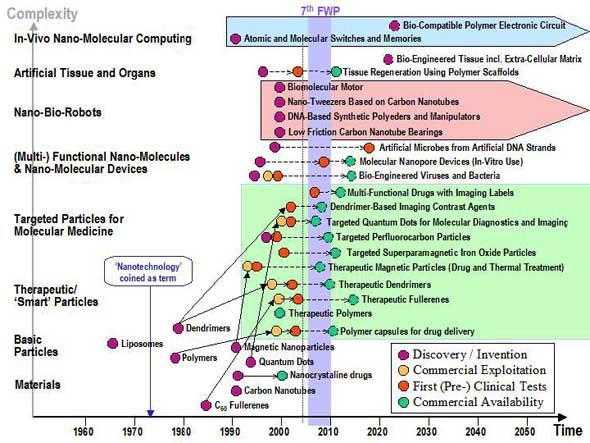
this shows the many different aspects and capabilities related to nanomedicine
The expected change in the understanding of disease that they discuss in this quote:
Future nanomedical diagnostics with an ultimate level of sensitivity will enable doctors to discover the slightest abnormality in our bodies – raising the question if and what clinical relevance such information will have.
“Diagnostic nanotechnologies eventually will provide the ability to detect and characterize individual cells, subtle molecular changes in DNA, or even minor changes in blood chemistry – scenarios that will likely cause pause and reconsideration of what it means to be a ‘healthy person’ versus a ‘person who has a disease'” says Bawa. “In a ‘nanoworld,’ we might have to reconsider how to diagnose someone who has, say, cancer. Is the presence of a genetic mutation known to have a predisposition for causing cancer in a single cell a diagnosis? Or is it simply a risk factor? How many cells from the body must be of a cancerous nature for it to be defined as cancer? 1? 50? 1000?”
Once diagnostic technologies have reached this stage it will require reconceptualizing understanding of disease
Silicon biosensors are being implanted into the body with a gel to prevent rejection.
There are bloodstream robots that are millimeter sized or smaller from Korea and Japan and and Israel.

Israel bloodstream robot
With the rejection suppression gel, rice grain size or larger computers could be placed into the body which would be an earlier cruder but possibly very functional version of what nanomedicine could accomplish. MEMS and NEMS will get very good over the next 5-10 years and the conservative expectations that we will need to wait for full blown nanotechnology for what are considered nanomedicine applications are wrong. Molecular nanotechnology will make what we can place into the body a millions times higher performance or more. However, even advanced silicon and polymer and pre-molecular nanotechnology will provide capabilities far beyond what those who ridicule “submarines in the body” expect.
Do not underestimate clever and creative use of existing and near term technology. It can deliver what some people think we need to wait for full blown molecular nanotechnology to get. It also means clever use of molecular nanotechnology will blow away all the unimaginitive scenarios.

Brian Wang is a Futurist Thought Leader and a popular Science blogger with 1 million readers per month. His blog Nextbigfuture.com is ranked #1 Science News Blog. It covers many disruptive technology and trends including Space, Robotics, Artificial Intelligence, Medicine, Anti-aging Biotechnology, and Nanotechnology.
Known for identifying cutting edge technologies, he is currently a Co-Founder of a startup and fundraiser for high potential early-stage companies. He is the Head of Research for Allocations for deep technology investments and an Angel Investor at Space Angels.
A frequent speaker at corporations, he has been a TEDx speaker, a Singularity University speaker and guest at numerous interviews for radio and podcasts. He is open to public speaking and advising engagements.


Comments are closed.